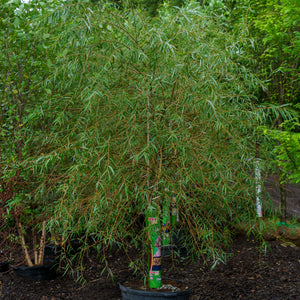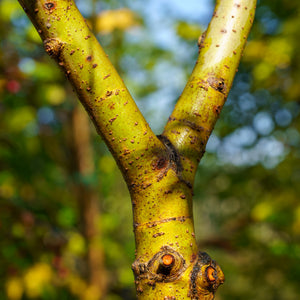The Willow Guide
Willows (Salix spp.) are a diverse group of deciduous trees and shrubs prized for their graceful form, rapid growth, and versatility in the landscape. With species ranging from large weeping trees to colorful ornamental shrubs, willows bring movement, texture, and seasonal interest to gardens, wetland edges, and open landscapes.
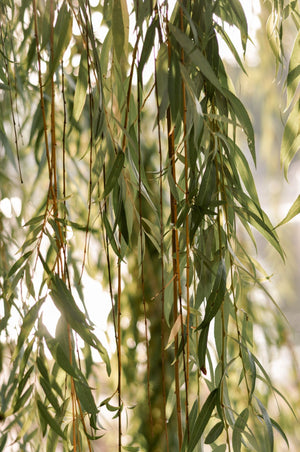
About
The Salix genus includes more than 400 species of trees and shrubs found throughout the Northern Hemisphere, especially in temperate and moist environments. Most willows prefer full sun and moist soils, making them particularly valuable in rain gardens, riparian buffers, and low-lying areas.
Common species and cultivars include:
- Salix babylonica (Weeping Willow): The classic weeping form, growing up to 50 feet tall with long, trailing branches that sway in the wind.
- Salix alba 'Tristis' (Golden Weeping Willow): A fast-growing tree with golden-yellow stems and graceful weeping form.
- Salix caprea (Pussy Willow): A smaller tree or large shrub known for its silvery, fuzzy catkins that appear in late winter to early spring.
- Salix gracilistyla ‘Mt. Asama’ (Japanese Pussy Willow): Grown for its striking reddish catkins that emerge in late winter.
- Salix integra 'Hakuro-Nishiki': A dwarf ornamental shrub with pink, white, and green variegated foliage, popular in container gardens and borders.
- Salix matsudana 'Tortuosa' (Corkscrew Willow): Known for its spiraled branches and upright growth habit, often used for winter interest and floral arrangements.
Willows are fast growers—some putting on several feet of growth per year—and they establish quickly, making them ideal for erosion control and fast screening. They support wildlife, provide shelter, and offer early-season nectar for pollinators.
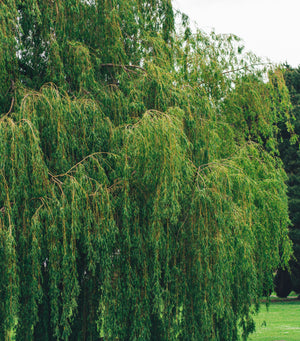
PLANTING
USDA Hardiness Zones: Most willows are hardy in Zones 4–9, with some species extending to Zone 3 or Zone 10 depending on origin and variety.
Soil: Moist, fertile, well-drained soils are ideal. Tolerates clay and occasionally wet or poorly drained conditions. Avoid prolonged drought and compacted soils.
Sunlight: Full sun (6+ hours/day) is preferred. Some shrub willows tolerate partial shade but may become leggy.
Watering: Water frequently during establishment. Most willows prefer consistent moisture but can adapt to brief dry periods once mature.
Spacing: Large trees like Salix babylonica should be spaced at least 30–40 feet apart. Smaller or shrubby types like 'Hakuro-Nishiki' can be spaced 4–6 feet apart depending on use.
Planting Time: Plant in early spring or fall when soil temperatures are cool. Container-grown plants may be planted throughout the growing season with proper watering.
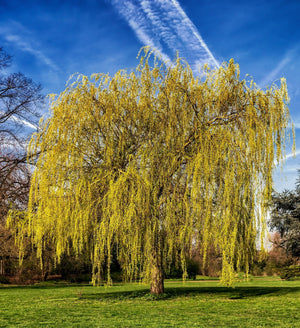
CARE
Watering: Keep the soil consistently moist, especially during hot, dry weather. Deep watering supports root development and canopy health.
Fertilizing: Not usually necessary in fertile soils. Apply a balanced fertilizer in early spring if growth appears weak or foliage is pale.
Pruning: Prune willows in late winter or very early spring before new growth begins. Remove dead, damaged, or crossing branches and shape as desired. For ornamental varieties like 'Hakuro-Nishiki', prune annually to maintain color and compact form.
Pests and Diseases: Willows can be susceptible to cankers, rust, aphids, and willow leaf beetle. Good airflow, regular cleanup of fallen debris, and proper spacing help reduce issues.
Mulching: Apply a 2–3 inch mulch layer to conserve soil moisture and regulate soil temperature. Keep mulch a few inches from the trunk or main stems.
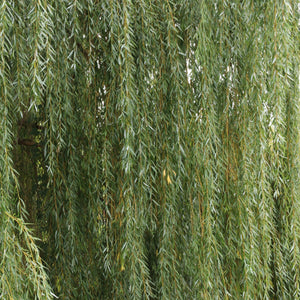
HOW TO USE
Shade and Specimen Trees: Large willows such as Salix babylonica or Salix alba 'Tristis' make excellent shade trees in spacious landscapes or near ponds.
Erosion Control: Willows' aggressive root systems stabilize streambanks, ditches, and slopes. Use along water edges or in low-lying wet zones.
Rain Gardens and Wet Areas: Willows thrive in consistently moist soils and are perfect for managing runoff or standing water.
Ornamental Shrubs: Varieties like 'Hakuro-Nishiki' add color and texture to garden beds, patios, and container gardens.
Winter Interest: Species like Salix matsudana 'Tortuosa' provide architectural beauty with twisted branches and colorful stems.
Pollinator Support: Early-blooming species such as pussy willows provide essential nectar for emerging bees in late winter.
Cut Flower and Craft Use: Branches from corkscrew and pussy willows are widely used in floral design and seasonal decor.
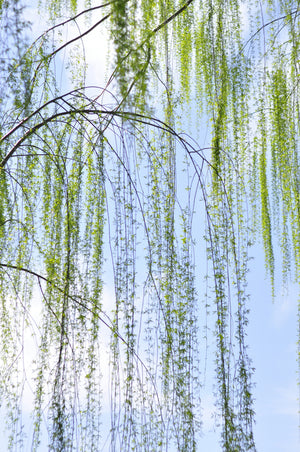
Common Questions
Where do willow trees grow? Willows naturally grow in temperate regions, especially near water sources like streams, ponds, and wetlands. They prefer moist, sunny environments.
How fast do willow trees grow? Willows are among the fastest-growing trees. Many can grow 3 to 6 feet per year under ideal conditions.
How long do willow trees live? Most willows live 30 to 50 years, though some species may live longer. They grow quickly but may decline earlier than slower-growing hardwoods.
How tall do willows grow? Large willow trees can reach 40 to 60 feet tall. Ornamental and shrub varieties stay much smaller, often under 10 feet.
When do willow trees bloom? Bloom time varies by species but generally occurs in late winter to early spring. Pussy willows are among the earliest bloomers.
How to prune a willow? Prune in late winter by removing deadwood, thinning crowded branches, and shaping the canopy. For shrub forms, annual rejuvenation pruning encourages fresh growth.
When to prune a willow? Prune before new spring growth begins—typically late winter to very early spring.
Conclusion
Willows are dynamic, fast-growing trees and shrubs that offer elegance, ecological value, and adaptability. From their weeping silhouettes to their colorful stems and early catkins, willows deliver year-round impact in gardens, wetlands, and open spaces. Whether you're planting for shade, erosion control, pollinators, or visual drama, Salix species offer a wide range of options to enrich and enliven the landscape.
The Willow Collection
Sold Out
Sold Out

